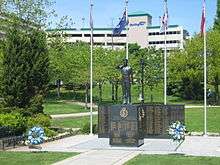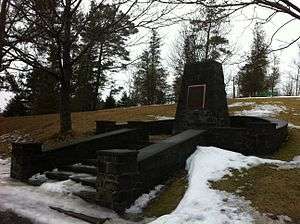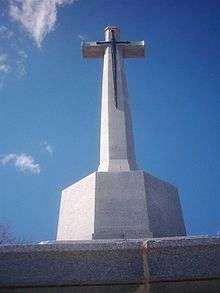Canadian Merchant Navy
Canada, like several other Commonwealth nations, created the Canadian Merchant Navy in a large-scale effort during World War II.
History

An informal merchant navy appeared in 1914 at the start of World War I and was renamed Canadian Government Merchant Marine in 1918, but slowly disappeared by 1930.[1]
Within hours of Canada's declaration of war on 10 September 1939, the Canadian government passed laws to create the Canadian Merchant Navy setting out rules and controls to provide a workforce for wartime shipping. The World War II Merchant Navy greatly expanded the similar World War I effort. The Canadian Merchant Navy played a major role in the Battle of the Atlantic bolstering the allies’ merchant fleet due to high losses in the British Merchant Navy. Eventually thousands of Canadians served aboard hundreds of Canadian Merchant Navy ships, notably the "Park Ships", the Canadian equivalent of the American "Liberty Ships". Rear Admiral Leonard W. Murray reported,
The Battle of the Atlantic was not won by any Navy or any Air Force, it was won by the courage, fortitude and determination of the British and Allied Merchant Navy.[2]
A school was established at St. Margaret's Bay, Nova Scotia to train sailors for the Canadian Merchant Navy, who became known as "Merchant Mariners." Manning Pools, or barracks, were built in major Canadian ports to house Merchant Mariners. The Merchant Navy was considered a fourth branch of the Canadian military alongside the Royal Canadian Navy, Canadian Army, and the Royal Canadian Air Force, and suffered the highest casualty rate of the four.
After the war, Canadian Merchant Navy veterans were denied veterans benefits and official recognition for decades. This was not corrected until the 1990s and many individual cases remain unresolved. Similar to the CMM Veterans status, World War II United States Merchant Marine Veterans were also denied veterans benefits and status until 1988.
An important gesture in 2003 was the designation by the Canadian Parliament of the Merchant Navy Remembrance Day on 3 September as a day to recognize the contributions and sacrifice of Canadian Merchant Mariners.[3]
The Merchant Navy slowly disappeared until by 1950 no Merchant Navy ships were left.[4]
Memorials


- "Royal Canadian Naval Association Naval Memorial (1995)" by André Gauthier (sculptor) was erected on the shore of Lake Ontario in Spencer Smith Park in Burlington, Ontario. The 6'4" high cast bronze statue depicts a World War II Canadian sailor in the position of attention saluting his lost shipmates. The model for the statue was a local Sea Cadet wearing Mike Vencel's naval service uniform.[5] On the black granite base, the names of Royal Canadian Navy and Canadian Merchant Navy ships sunk during World War II are engraved.[6]
- A commemorative plaque in SS Point Pleasant Park, Halifax, Nova Scotia unveilled in 1967, "When the United Kingdom declared war on Germany in 1914, Canada and Newfoundland's participation was virtually unquestioned. With the onset of the Second World War in 1939 Canadians and Newfoundlanders once more rushed to enlist and were a major factor in the Allied victories in both conflicts. During two world wars the main duty of the Royal Canadian Navy was to escort convoys in the Atlantic and guard merchant vessels against the threat of attack by German submarines. In the Second World War, it also escorted ships in the Mediterranean and to Russia and supported the Allied landings in Sicilian, Italian and Normandy campaigns as well as in the Pacific. The Canadian Merchant Navy's duties included the transportation of troops and supplies to the Allied armies and food for the United Kingdom, extremely dangerous work which resulted in considerable losses."
- at the Maritime Museum of the Atlantic in Halifax, Nova Scotia. "In memory of 2200 known Canadian Merchant Seamen and 91 Canadian vessels lost by enemy action and those who served in the cause of freedom – World War I 1914–1918; World War II 1939–1945; Korean Conflict 1950–1953"
- A monument in Windsor, Ontario, Canada "Dedicated to the men and women who served on the Royal Canadian Navy and the Canadian Merchant Navy [7] , this includes those who served in World War I, World War II, and the Korean War. This monument sits along the Detroit River within the Windsor Sculpture Park in the Dieppe Gardens, named in memory of the soldiers who lost their lives in the 1942 landing at Dieppe.
Monuments to the Canadian Merchant Navy were erected in several Canadian cities:

 Halifax Memorial, Point Pleasant Park dedicated to the Canadian servicemen and women who died at sea during both World Wars and includes the Korean War
Halifax Memorial, Point Pleasant Park dedicated to the Canadian servicemen and women who died at sea during both World Wars and includes the Korean War
Fleet
World War II
Canadian-registered
|
|
|
Statistics
|
| Statistics for the shipping industry of Canada | |||||
|---|---|---|---|---|---|
| Total: 184 ships (1,000 gross register tons (GRT) or over) | |||||
| Totalling: 2,129,243 GRT/2,716,340 tonnes deadweight (DWT) | |||||
| Cargo ships | |||||
| Bulk ships | 66 | ||||
| Cargo ship | 12 | ||||
| Combination bulk ships | 1 | ||||
| Container ships | 2 | ||||
| Roll-on / roll-off ships | 6 | ||||
| Vehicle carrier | 1 | ||||
| Tankers | |||||
| Chemical tanker ships | 14 | ||||
| Petroleum tanker ships | 12 | ||||
| Passenger ships | |||||
| General passenger ships | 6 | ||||
| Combined passenger/cargo | 64 | ||||
| |||||
| Source: This article contains material from the CIA World Factbook which, as a US government publication, is in the public domain. | |||||
See also
References
- ↑ http://www.veterans.gc.ca/eng/remembrance/history/valour-at-sea
- ↑ Notes prepared by Admiral Murray for CBC interview in 1967, Library and Archives of Canada, Admiral Murray papers, Collection MG30 E207
- ↑ "R-03-2001: A Resolution to designate the 3rd of September each year as "Merchant Navy Day"". Company of Master Mariners of Canada. Archived from the original on April 14, 2009. Retrieved August 7, 2014.
- ↑ http://www.veterans.gc.ca/eng/remembrance/history/valour-at-sea
- ↑ Royal Canadian Naval Association Naval Memorial Archived March 22, 2013, at the Wayback Machine.
- ↑ Royal Canadian Naval Association Naval Memorial
- ↑ https://www.citywindsor.ca/residents/Culture/Monuments/Pages/Anchor-Memorial.aspx